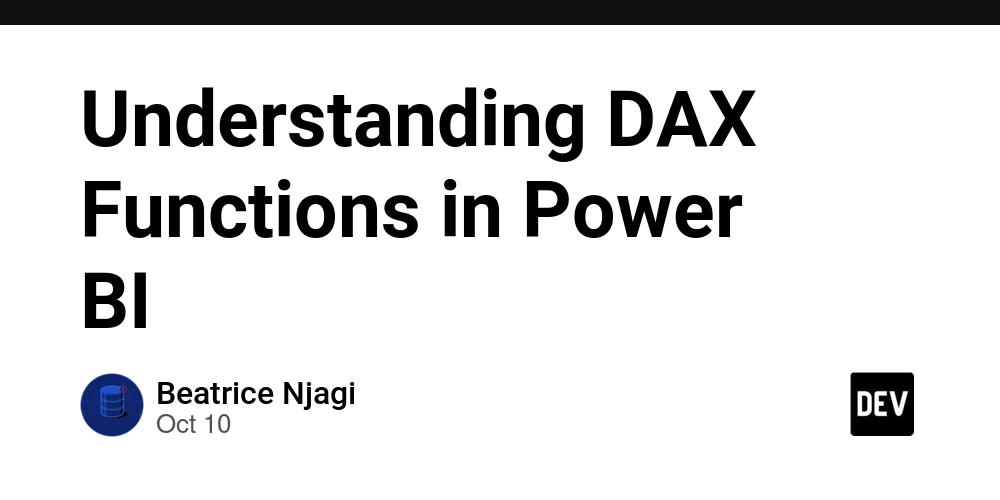Power BI stands for Power Business Intelligence—a powerful platform that enables users to transform raw data into clear, actionable, and interactive visualizations, supporting data-driven decision-making, collaboration through shared dashboards, and efficiency through automated data refreshes.
At the heart of Power BI lies Data Analysis Expressions (DAX) — a formula language that powers calculations, aggregations, and data modeling. DAX allows users to create custom, powerful formulas that extend beyond what standard Excel functions can achieve.
DAX functions are categorized by their purpose. In this article, we’ll explore four key categories:
- Mathematical Functions (SUM, AVERAGE)
- Text Functions (LEFT, RIGHT, CONCATENATE)
- Date & Time Functions (YEAR, TOTALYTD, SAMEPERIODLASTYEAR)
- Logical Functions (IF, SWITCH)
Each category plays a unique role in analyzing and managing data effectively.
1. Mathematical Functions (SUM, AVERAGE)
Mathematical DAX functions perform numeric calculations such as totals, averages, minimums, or maximums.
Common Functions:
SUM() – Adds up all the values in a column.
AVERAGE() – Calculates the mean value in a column.
Example (Kenya Crop Dataset):
The dataset includes columns such as County, Crop Type, Market Price (KES/Kg), Farmer, and Revenue (KES).
To find total revenue and the average market price:
- Total Revenue = SUM(Kenya_Crops_Dataset[Revenue (KES)])
- Average Market Price = AVERAGE(Kenya_Crops_Dataset[Market Price (KES/Kg)])
2. Text Functions (LEFT, RIGHT, CONCATENATE)
Text DAX functions manipulate string data — ideal for data cleaning, formatting, or combining text fields. These functions help structure data more clearly for reporting and analysis.
Common Functions:
LEFT() – Extracts a specific number of characters from the start of a text string.
RIGHT() – Extracts characters from the end of a text string.
CONCATENATE() – Joins two or more text strings into one.
Example (Kenya Crop Dataset):
To extract the first and last three letters from the Crop Type column:
- First Three Letters = LEFT(Kenya_Crops_Dataset[Crop Type], 3)
- Last Three Letters = RIGHT(Kenya_Crops_Dataset[Crop Type], 3)
To combine Farmer Name and Crop Type into one field:
- Crop and Farmer = CONCATENATE(Kenya_Crops_Dataset[Farmer Name], ” ” & Kenya_Crops_Dataset[Crop Type])
3. Date & Time Functions (YEAR, TOTALYTD, SAMEPERIODLASTYEAR)
Date and time DAX functions are essential for analyzing trends over time. They help track seasonal patterns, compare year-over-year performance, and forecast future outcomes.
Common Functions:
YEAR() – Extracts the year from a date field.
TOTALYTD() – Calculates the year-to-date total for a given measure.
SAMEPERIODLASTYEAR() – Compares performance for the same period in the previous year.
Example (Kenya Crop Dataset):
- Year = YEAR(Kenya_Crop_Dataset[Date])
- YTD Revenue = TOTALYTD(SUM(Kenya_Crop_Dataset[Revenue (KES)]), Kenya_Crop_Dataset[Date])
- Previous Year Revenue = CALCULATE(SUM(Kenya_Crop_Dataset[Revenue (KES)]), SAMEPERIODLASTYEAR(Kenya_Crop_Dataset[Date]))
4. Logical Functions (IF, SWITCH)
Logical functions test conditions and return specific results depending on whether those conditions are TRUE or FALSE. They are useful for categorizing, flagging, or grouping data based on performance or attributes.
Common Functions:
IF() – Tests a condition and returns one value if true, another if false.
SWITCH() – Evaluates an expression against multiple possible outcomes and returns a result for the first match.
Example (Kenya Crop Dataset):
To categorize Market Price into low, median, or high:
Market Price Category = IF(Kenya_Crops_Dataset[Market Price (KES/Kg)] > 100.68, “High”, “Low”)
Or using SWITCH() for multiple conditions:
Market Category v2 =
SWITCH(
TRUE(),
Kenya_Crops_Dataset[Market Price (KES/Kg)] < 100.68, “Low”,
Kenya_Crops_Dataset[Market Price (KES/Kg)] = 100.68, “Median”,
Kenya_Crops_Dataset[Market Price (KES/Kg)] > 100.68, “High”,
“Invalid”
)
Conclusion
Power BI and DAX together form a powerful analytical engine for turning data into actionable insights. For instance, farmers, agribusinesses, and policymakers can use DAX functions to identify trends, monitor performance, and make informed decisions. With these tools, users can predict harvest outcomes, allocate resources efficiently, and optimize profitability across seasons.



